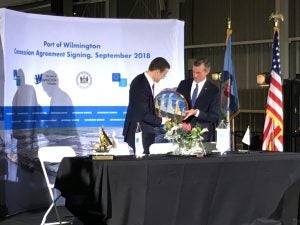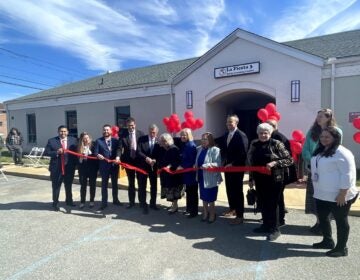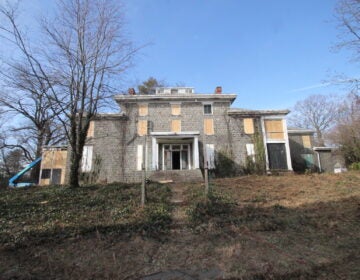UAE-based Gulftainer signs 50-year lease for Port of Wilmington
As part of the deal, Gulftainer will upgrade facilities and expand the Port of Wilmington, potentially creating hundreds of jobs along the way.
Listen 1:15
Delaware signed a deal to lease the Port of Wilmington to UAE-based Gulftainer Tuesday, Sept. 18. (Mark Eichmann/WHYY)
The Port of Wilmington is now in the hands of United Arab Emirates-based Gulftainer. Gov. John Carney signed an agreement with Badr Jafar, the chairman of Gulftainer’s executive board, during a ceremony at the port Tuesday afternoon. While Delaware will retain ownership of the land, Gulftainer will operate the port for the next 50 years — upgrading facilities, expanding operations and adding employees along the way.
“This is a really big deal,” Carney said before a crowd of dignitaries from Delaware and the United Arab Emirates assembled in a warehouse at the port. “What we’re going to do here today is to secure the jobs of the people and families who work here at the port and those who are going to work in the years to come.”
As part of the deal, Gulftainer will pay the state an annual royalty, starting at $6 million this year. The payment, which is dependent on the volume of cargo the port handles, is expected to increase to $13 million per year by 2027.

The company will spend $410 million to construct a new container port facility at DuPont’s former Edgemoor site just north of the existing port. And it will devote another $170 million to upgrading the existing facility.
That will help the port reach its “full potential” Jafar said. “The port’s enhanced operations will have the potential to generate well over 6,000 direct and indirect new jobs, including high-tech jobs over the coming decade.”
Increased capacity at the port is expected to generate $1.2 billion in economic activity for the state of Delaware, according to Jafar.
“This will firmly establish the Port of Wilmington as the largest logistics facility on the Delaware River, and the leading food gateway of the East Coast,” Jafar said.
Local union leaders cheered the prospect of new jobs at the expanded port, but it took lots of long hours and late nights to hammer out an agreement between the state, Gulftainer, and the International Longshoreman Association Local 1694.
The union push
“It was a dream, and a lot of people thought this dream would never come true,” said ILA 1694 President Bill Ashe. “I’m going to be honest and candid, there were too many naysayers that didn’t think this could happen.”
Delaware Secretary of State Jeffrey Bullock said it ILA leaders pushed for an expanded port long before other state leaders got on board.
“I’m happy about a lot of things, but I am happiest for the [union] guys,” Bullock said. “The kinds of jobs that we’re going to create at this port, and hopefully the new port up the river, are the exact kinds of jobs we need to be creating to secure our state’s future.”
The Port of Wilmington is now the second U.S. port controlled by Gulftainer. The company took over the Port of Canaveral in Florida about four years ago. Since then, new container and cargo services at Canaveral have increased cargo volume more than 150 percent in 2017. Gulftainer touts itself as the world’s largest privately owned port operator, with facilities on four continents.
The company’s agreement with the state will “cement Wilmington’s role in regional as well as global logistics,” Jafar said. He said the company has long wanted to tap into the potential of the North American market.
“Today’s landmark public/private partnership promises to propel the Port of Wilmington toward becoming the principal gateway of the U.S. East Coast,” he said.
In June, federal officials completed a review of the lease deal. The Committee on Foreign Investment in the U.S. determined the deal was “not a covered transaction,” and it cleared the way for completing the agreement.
WHYY is your source for fact-based, in-depth journalism and information. As a nonprofit organization, we rely on financial support from readers like you. Please give today.





